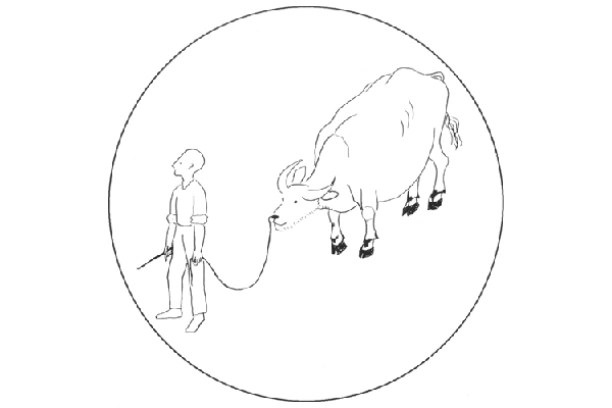
The door of Ch’an is entered by Wu. When we meditate on Wu we ask “What is Wu?” On entering Wu, we experience emptiness; we are not aware of existence, either ours or the world’s.
E-MAIL: admin@relaxmid.com

The fifth picture is the true ox herding picture. The ox herder, with a whip in one hand and a rein through the ox’s nose, is leading the animal. The ox can now be considered tame, though it may wander off if the ox herder becomes lax and doesn’t pay attention.
Self-cultivation now comes naturally; it is part of one’s everyday life. But a few vexations may remain, so one must continue working on samadhi in order to control them.
Ch’an enlightenment, which can be achieved through kung-an (koan) practice, is not gained through samadhi or concentration power. Kung-an practice and samadhi practice are different types of concentration.
Think of kung-an practice as a method of taking one’s vexation, or wandering thoughts, and pushing them all into one concentrated spot until there is no place to push them any more, at which point they explode, just as a balloon bursts when it is over-inflated. We use “doubt sensation” to concentrate the mind, to focus it until the final explosion. The strength of the explosion depends on the force behind it. The balloon may burst into many pieces, or only get a small hole in it. In kung-an practice, the goal is to thoroughly blow apart the concentrated mind.
I also use the analogy of throwing a rock into water. If a person with little vexation uses the “doubt” method, it is like throwing a big rock into a small puddle. The water is scattered, and all that remains is the rock.
That’s the aim of the method. However, if the person practicing has many vexations and doesn’t really penetrate the method, then the final result will be like throwing a pebble into a lake. There’ll be a splash, but not enough to see the bottom of the lake.
Focusing on the doubt sensation is not the same as samadhi, which is a deeper, more unmoving concentration. Samadhi can help to keep the mind peaceful and stable, with minimal emotions.
Samadhi practice is necessary after a kensho experience. With this practice you can gain full control of suppressed vexations, and disperse vexations which have already manifested. However, the samadhi you cultivate after a kensho experience is quite different from the samadhi you practice before having seen your self-nature.
Therefore, the person who has seen his self-nature still needs both precepts and samadhi. The precepts will help prevent the person from doing things that will cause more vexation, and samadhi will help to eliminate those vexations which have not yet manifested.
PREVIOUS: The Fourth Picture | Ox Herding at Morgan’s Bay
NEXT: The Sixth Picture | Ox Herding at Morgan’s Bay
